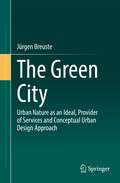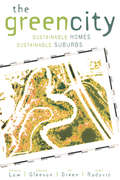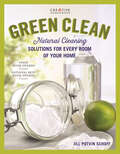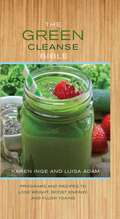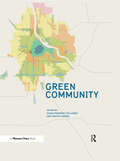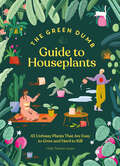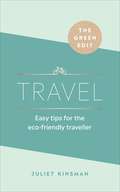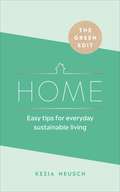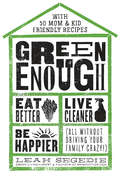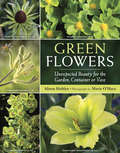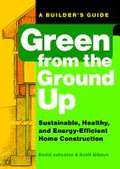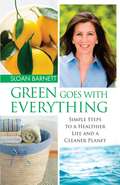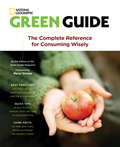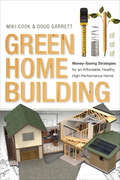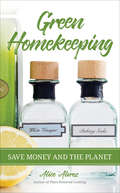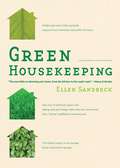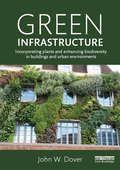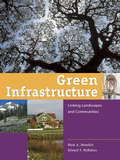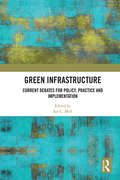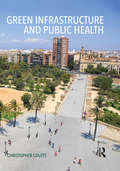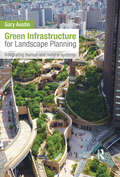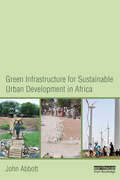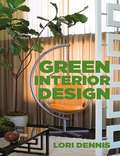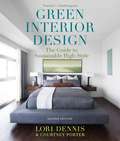- Table View
- List View
The Green City: Urban Nature as an Ideal, Provider of Services and Conceptual Urban Design Approach
by Jürgen BreusteThis textbook on the Green City examines urban nature as an ideal, provider of services and conceptual urban design approach. It answers important contemporary questions that arise about the ecological and cultural interactions, development and structure, and ecological performance of urban nature worldwide. The book explains what urban nature is, how it came to be, and how it evolved in the context of the natural and cultural conditions of its sites. It also describes what constitutes urban biodiversity and the role of differentiated urban nature in the Green City concept. Theories of urban development and ecology are linked to practical applications of urban planning and illustrated with many case studies and examples. The great potentials of urban nature are shown in detail. In order to cope with or mitigate problems in the city, a targeted urban nature management adapted to the specific conditions of the different types of urban nature is needed, which includes nature conservation as well as nature design, always keeping in mind the relation to the urban dwellers. The textbook is especially addressed to students and teachers of urban planning, ecology, geography, social sciences as well as practitioners of urban design and nature conservation. This book is a translation of the original German 1st edition Die Grüne Stadt by Jürgen Breuste, published by Springer-Verlag GmbH Germany, part of Springer Nature in 2019. The translation was done with the help of artificial intelligence (machine translation by the service DeepL.com). A subsequent human revision was done by the author primarily in terms of content and scientific terms, so that the book will read stylistically differently from a conventional translation but without loss of messages. Springer Nature works continuously to further the development of tools for the production of books and on the related technologies to support the authors.
The Green City: Sustainable Homes, Sustainable Suburbs
by Darko Radovic Ray Green Brendon Gleeson Nicholas LowA team of city-building professionals explain in straightforward terms how the idea of ecological sustainability can be embodied in the everyday life of homes, communities and cities to make a better future.The book considers - and answers - three questions: What does the global agenda of sustainable development mean for the urban spaces where most people live, work and move? Can we keep what we love about suburban life and still save the environment? And what new methods of planning and building will be needed in the 21st century? Rejecting both economic and environmental orthodoxy, the book’s essential message is that the sustainable city can be built by a thousand well-directed small changes. It draws on practical case material from around the world and weaves together four critical aspects of urban life: housing, open space, workplaces and transport. A 'photographic essay' of 32 colour plates illustrates the ideas discussed.
Green Clean: Natural Cleaning Solutions for Every Room of Your Home
by Jill Potvin SchoffA guide to environmentally safe cleaning techniques and products to keep you and your family safe from household toxins. This eco-friendly handbook explains how to eliminate toxic chemical household cleaning agents from your life and replace them with natural, homemade solutions. Inspired by the author's experience as the mother of an allergic child, Green Clean provides practical, comprehensive advice for every household cleaning need from kitchen, bathroom, and laundry to windows, floors, grills, decks, and cars. Jill Potvin Schoff shows how to green up your chores and reduce your family&’s exposure to hazardous chemicals. Using safe, effective and inexpensive ingredients and recipes, she offers simple cleaning methods and smart tips that will keep both you and the environment healthy.
The Green Cleanse Bible: Programs and recipes to lose weight, boost energy, and flush toxins
by Karen Inge Luisa AdamCleanse and detoxify your body with hundreds of smoothie recipes and meal plans in The Green Cleanse Bible. Boost your immunity, nutrient intake, and weight loss by blending fruits and vegetables in tasty combinations--some you may have never thought of! Increase your energy level with apples, kiwifruit, parsley, avocados, kale, spinach, and a host of other great "green" foods that span all colors of the rainbow. With ideas about what to look for in your garden or grocery store, how to prepare it, and what foods to pair it with, this book is a complete guide to green cleansing.
Green Community
by Timothy Mennel Susan Piedmont-PalladinoThe health of our planet and ourselves depends on how we plan, design, and construct the world between our buildings. Our increasing dependence on fossil fuels over the last century has given us unprecedented individual mobility and comfort, but the consequences are clear. Climate change, sprawl, and reliance on foreign oil are just a few of the challenges we face in designing new-and adapting existing-communities to be greener. Based on the National Building Museum's Green Community exhibition, this book is a collection of thought-provoking essays that illuminate the connections among personal health, community health, and our planet's health. Green Community brings together diverse experts, each of whom has a unique approach to sustainable planning, design, politics, and construction.
Green Dumb Guide to Houseplants: 45 Unfussy Plants That Are Easy to Grow and Hard to Kill
by Holly Theisen-JonesFor those who want to take care of houseplants but can hardly take care of themselves, The Green Dumb Guide to Houseplants is the perfect handbook for even the most greenery-inept individual.We all love the idea of houseplants, and maybe you've stood by helplessly as a cactus went all slimy or you've endured the perpetual indoor autumn of an unhappy Ficus. Good news—all of the plants in this book have two things in common: They're easy to find and hard to kill.The benefits of plant ownership are legion. Studies indicate just being around plants creates a relaxing effect on people. And plants make great roommates—no Peace Lily will ever criticize you for quitting your workout video to go finish a box of Triscuits. Does your bedroom have a mattress on the floor and Christmas lights taped to the wall? Put a Money Tree in the corner. Instant upgrade! Are you a corporate lackey trapped under fluorescent lights and a drop-tile ceiling? A colorful Calathea or a chunky little Aloe could help restore your will to live. The Green Dumb Guide to Houseplants is full of useful advice, crucial dos and don'ts, and realistic inspiration for all budgets and attention spans—ensuring success to even the most risk-averse, commitment-phobic indoor gardeners.THE EASIEST POSSIBLE GUIDE TO LEARNING THE BASICS OF PLANT CARE: No skills needed, except knowing how to read this book.FORTY-FIVE HOUSEPLANT PROFILES: EACH ONE EASY TO FIND AND HARD TO KILL: Divided into difficulty sections ranging from "Practically Plastic," "Chill," "Fussy," or "Master Gardener" (only one of those!), this handy houseplant book ensures you choose the right plant for your level of commitment.IF ALL ELSE FAILS, A BONUS SECTION ON HOW TO CHOOSE PLASTIC PLANTS: Shade doesn't only come from plants! Take your absolutely true advice with a healthy dose of humor.Perfect for:Everyone who has ever tried and failed to grow houseplantsDIY decoratorsAnyone starting out in a new home or apartmentA great gift for grads, newlyweds, and hosts or hostesses (along with a plant, of course)
The Green Edit: Easy tips for the eco-friendly traveller
by Juliet KinsmanExplore the world and satisfy your wanderlust in the most eco-friendly way.How can we lessen our impact on the world without giving up the things we love? This series of easy-to-follow guides show that positive change is possible without radical changes to your everyday life.Sustainable tourism doesn’t have to mean vowing to never take another flight or spending holidays camping in your back garden. This short expert guide from eco-travel journalist Juliet Kinsman, takes you through every step of planning your trip, from booking to boarding, and arms you with everything you need to know for a lower-impact getaway.Whether it's explaining how to know which plane to take (yes, some are greener than others) or how to avoid the mini toiletries trap; this book shows that you can save the planet and still live life to the full.
The Green Edit: Easy tips for everyday sustainable living
by Kezia NeuschCreate a happy, beautiful and eco-friendly homeHaving a happy, healthy home is a key part of our wellbeing, but how do we ensure the pursuit of our perfect living space doesn't negatively impact on the environment?Blogger and low-waste expert Kezia Neusch provides simple swaps and genius hacks to help you reduce your household’s ecological footprint, covering everything from how to break up with your tumble dryer and why your mid-morning snack might be harming the planet.This book contains everything you need to know to create a sustainable home for you and your family.
Green Enough: Eat Better, Live Cleaner, Be Happier--All Without Driving Your Family Crazy!
by Leah SegedieA real, no-holds-barred take on making smart, healthy choices for you and your family.In Green Enough, Mamavation blogger Leah Segedie uncovers the truth behind the food and household products that are misleadingly labeled "all-natural" and healthy but are actually filled with chemicals and toxins. From furniture to packaged food, Leah guides you through detoxifying your home, diet, and lifestyle, showing you how to make the best choices possible. She exposes the brands and products that contain toxic and hormone-disrupting ingredients and gives guidelines on choosing safer products and organic produce that are free from toxic and persistent pesticides. She instructs you on making the move to meat, dairy, and eggs that are free of antibiotics, GMOs, growth hormones, and dangerous pathogens. She explains at what phases of childhood children are the most vulnerable and need more protection. And she includes delicious and kid-approved recipes to help you detoxify your cooking routine. It’s not about being perfect or 100% clean—none of us are—it’s about being green enough.
Green Flowers: Unexpected Beauty for the Garden, Container or Vase
by Alison Hoblyn Marie O'HaraGreen in the garden is at once the most common color of foliage and the rarest color found in flowers. Whether you're a home gardener looking for a jolt of freshness or a floral designer seeking inspiration, this charming collection of unexpected plants provides a palette of flowering greens for year-round display. Combining Marie O'Hara's sumptuous photography and Alison Hoblyn's evocative text, Green Flowers explores the history, botany, care, and cultivation of green-flowered plants. The hand-picked selection includes trees, grasses, vines and climbers, annuals, perennials, bulbs, wildflowers, exotics, orchids, edible plants, and water garden plants. The appeal of the selection is broad: Jack-in-the-pulpit provides curiosity; fritillaries and columbines lend quiet beauty; and green roses, hellebores, and irises are an excellent foil to their more colorful companions. Eighty-four plants are included in all. Complete tips on growing and arranging the plants are given for each entry, as well as an account of the interesting myths, history, and lore.
Green From the Ground Up: Sustainable, Healthy, And Energy-Efficient Home Construction (Builder's Guide Ser.)
by David Johnston Scott GibsonMy passion for green building is based on experience. I know that building green results in better houses and that it improves the lives of the people who live in them, not to mention the health of our planet.
Green Goes with Everything
by Sloan BarnettImagine if your best friend gave you vital information that could protect you and your family, and save you money, and help the planet. Imagine if you were given clear, simple choices, small changes that could have a big impact on your life. And you could still wear leather shoes and deodorant. You'd listen, right? Well, think of Today show contributor Sloan Barnett as that friend. A mother of three, a dedicated consumer advocate, Sloan gives us a fast, simple, down-toearth primer on the ways our homes are making us sick, and what we can all do to transform them into the safe sanctuaries we want and need them to be. Sloan exposes the toxic truth behind the household products we use every day -- from laundry detergent to toothpaste to lipstick. She explains how these and other seemingly benign stuff can harm us and our children. She offers an array of alternatives, and inspires us to see that we're never helpless: Every day, we have the power to make better, smarter, safer choices. Packed with common sense and sass, product picks and practical tips, Green Goes With Everything is for everyone who wants to live a healthier life.
Green Guide: The Complete Reference for Consuming Wisely
by Editors of Green GuidePaper or plastic? Organic or conventional? In a world that is rapidly going "green," how does the average person make decisions that are smart for the family-and good for the planet? The Green Guide is here to help, with the concepts and choices for Earth-conscious living. Presented in concise, information-packed chapters, this up-to-the-minute resource touches on every aspect of our lives, from grocery shopping to housecleaning to work, travel, and investing-enabling consumers to make informed decisions and simple changes that impact the planet in big ways. Easy-to-follow information and hundreds of fascinating sidebars, fact boxes, and other key elements recommend how you can replace unhealthy and environmentally damaging practices and products with more wholesome, comfortable, and aesthetically pleasing alternatives. Neither scholarly nor scare-mongering in tone, the lively text has been written in partnership with a board of noted experts-offering readers the most authoritative, engaging, comprehensive, and in-depth reference of its kind.Created by two of the strongest brands in conservation and the environment, and drawn from more than ten years of reputable coverage in The Green Guide newsletter, on-line and in print, this comprehensive resource is destined to become a must-have for millions of families and the first name in household reference books in this up-and-coming category.
Green Guide: The Complete Reference for Consuming Wisely
by Meryl StreepPaper or plastic? Organic or conventional? The Green Guide is here to help, with the concepts and choices for Earth-conscious living. Presented in concise, information-packed chapters, this up-to-the-minute resource touches on every aspect of our lives, from grocery shopping to housecleaning to work, travel, and investing, enabling consumers to make informed decisions and simple changes that impact the planet in big ways. Easy-to-follow information and hundreds of fascinating sidebars, fact boxes, and other key elements recommend how you can replace unhealthy and environmentally damaging practices and products with more wholesome, comfortable, and aesthetically pleasing alternatives. Neither scholarly nor scare-mongering in tone, the lively text has been written in partnership with a board of noted experts, offering readers the most authoritative, engaging, comprehensive, and in-depth reference of its kind. Created by two of the strongest brands in conservation and the environment, and drawn from more than ten years of reputable coverage in The Green Guide newsletter, on-line and in print, this comprehensive resource is destined to become a must-have for millions of families and the first name in household reference books in this up-and-coming category
Green Home Building: Money-Saving Strategies for an Affordable, Healthy, High-Performance Home
by Doug Garrett Miki CookAccording to conventional wisdom, building a green home is an expensive endeavor. The standard approach treats green as an add-on, tacking "premium" products, finishes, and equipment onto a traditional home design. As a result, many green home projects end up over budget or fail to achieve their environmental and performance goals.Green Home Building explodes the myth that green homes have to cost more. Using proven methods based on applied building science, the authors show how to: Lower base construction costs to provide funding for high performance upgrades Achieve a net-zero energy home, including "zero-ing" water, waste, carbon, and associated costs within fifteen years Live affordably into the future, despite anticipated rising costs for fuel, water, materials, taxes, and health careThis comprehensive guide to building green on any budget defines the strategies that maximize the return on green investments. Written for anyone who has ever been swayed by the argument that the price tag limits how green a home can be, Green Home Building is a must-read for builders, contractors, architects, designers, and homeowners.Miki Cook is a green building and sustainability consultant who has dedicated her career to educating contractors and the public on the strategies, methods, and benefits of green homes.Doug Garrett has trained thousands of homebuilders, architects, and sub-contractors to build energy-efficient homes using applied building science to improve comfort, durability, and healthfulness while meeting or exceeding the energy code.
Green Homekeeping: Save Money and the Planet
by Alice AlvarezFifty ways to make your home a sustainable and eco-friendly environment.Every decision you make, large and small, has an impact on the environment. This concise guide shows how you can make your daily impact planet-positive. With sections progressing from simple tips to deeper commitments, you can start with baby steps and move on to advanced eco-warrior!Discover dozens of inspired ideas that show how to:*Reduce your waste*Eat organic*Keep toxins out of your home*Compost leftover food*Shop wisely, and much more
Green Housekeeping
by Ellen SandbeckWant a low-maintenance bathroom that takes 30 seconds a day to clean? Need whiter whites that get whiter for free? Learn to live in a clean, healthy, more economical -- and Earth-friendly -- way with Ellen Sandbeck's Green Housekeeping, the must-have book for the twenty-first-century home. You will learn to maintain every part of your home -- from living room to septic tank, kitchen floor to bathroom sink -- using safe, simple cleansers and quick, preventative measures that will save you time and money, save your health, and save the planet.
Green Infrastructure: Incorporating Plants and Enhancing Biodiversity in Buildings and Urban Environments (Routledge Studies in Urban Ecology)
by John W. DoverWith more than half of the world's population now living in urban areas, it is vitally important that towns and cities are healthy places to live. The principal aim of this book is to synthesize the disparate literature on the use of vegetation in the built environment and its multifunctional benefits to humans. The author reviews issues such as: contact with wildlife and its immediate and long-term effects on psychological and physical wellbeing; the role of vegetation in removing health-damaging pollutants from the air; green roofs and green walls, which provide insulation, reduce energy use and decrease the carbon footprint of buildings; and structural vegetation such as street trees, providing shading and air circulation whilst also helping to stop flash-floods through surface drainage. Examples are used throughout to illustrate the practical use of vegetation to improve the urban environment and deliver ecosystem services. Whilst the underlying theme is the value of biodiversity, the emphasis is less on existing high-value green spaces (such as nature reserves, parks and gardens), than on the sealed surfaces of urban areas (building surfaces, roads, car parks, plazas, etc.). The book shows how these, and the spaces they encapsulate, can be modified to meet current and future environmental challenges including climate change. The value of existing green space is also covered to provide a comprehensive textbook of international relevance.
Green Infrastructure: Linking Landscapes and Communities
by Edward T. Mcmahon Lydia Bergen Mark A. Benedict Mark A. The Conservation FundWith illustrative and detailed examples drawn from throughout the country, Green Infrastructure advances smart land conservation: large scale thinking and integrated action to plan, protect and manage our natural and restored lands. From the individual parcel to the multi-state region, Green Infrastructure helps each of us look at the landscape in relation to the many uses it could serve, for nature and people, and determine which use makes the most sense. In this wide-ranging primer, leading experts in the field provide a detailed how-to for planners, designers, landscape architects, and citizen activists
Green Infrastructure: Current Debates for Policy, Practice and Implementation
by Ian C. MellOur understandings of the landscapes around us are constantly changing. How we interact with, manage and value these spaces is important, as it helps us to ensure we live in attractive, functional and sustainable places. Green Infrastructure planning is the current ‘go-to’ approach in landscape planning that incorporates human-environmental interactions, understandings of ecology and how socio-cultural factors influence our use of parks, gardens and waterways. This book explores several interpretations of Green Infrastructure bringing together case studies of policy, practice, ecological change and community understandings of landscape. Focusing on how planning policy shapes our interactions with the landscape, as individuals and communities, the book discusses what works and what needs to be improved. It examines how environmental management can promote more sustainable approaches to landscape protection ensuring that water resources and ecological communities are not harmed by development. It also asks what the economic and community values of Green Infrastructure are to illustrate how different social, ecological and political factors influence how our landscapes are managed. The central message of the book focusses on the promotion of multi-functional nature within urban landscapes that helps people, the economy and the environment to meet the challenges of population, infrastructure and economic change. The chapters in this book were origianally published as a special issue in Landscape Research.
Green Infrastructure and Public Health
by Christopher CouttsThere is a growing body of knowledge revealing a sweeping array of connections between public health and green infrastructure – but not until now have the links between them been brought together in one comprehensive book. Green Infrastructure and Public Health provides an overview of current research and theories of the ecological relationships and mechanisms by which the environment influences human health and health behaviour. Covering a broad spectrum of contemporary understanding, Coutts outlines: public health models that explicitly promote the importance of the environment to health ways in which the quality of the landscape is tied to health challenges of maintaining viable landscapes amidst a rapidly changing global environment This book presents the case for fundamental human dependence on the natural environment and creates a bridge between contemporary science on the structure and form of a healthy landscape and the myriad ways that a healthy landscape supports healthy human beings. It presents ideal reading for students and practitioners of landscape architecture, urban design, planning, and health studies.
Green Infrastructure for Landscape Planning: Integrating Human and Natural Systems
by Gary AustinGreen infrastructure integrates human and natural systems through a network of corridors and spaces in mixed-use and urban settings. Austin takes a broad look at green infrastructure concepts, research and case studies to provide the student and professional with processes, criteria and data to support planning, design and implementation. Key topics of the book include: The benefits of green infrastructure as a conservation and planning tool Requirements of ecosystem health Green infrastructure ecosystem services that contribute to human physical and psychological health Planning processes leading to robust green infrastructure networks Design of green infrastructure elements for multiple uses. The concept of ecosystem services is extensively developed in this book, including biological treatment of stormwater and wastewater, opportunities for recreation, urban agriculture and emersion in a naturalistic setting. It defines planning and design processes as well as the political and economic facets of envisioning, funding and implementing green infrastructure networks. The book differs from others on the market by presenting the technical issues, requirements and performance of green infrastructure elements, along with the more traditional recreation and wildlife needs associated with greenway planning, providing information derived from environmental engineering to guide planners and landscape architects.
Green Infrastructure for Sustainable Urban Development in Africa
by John AbbottThis book shows for the first time how green infrastructure can work in an African urban context. On one level it provides a major rethinking of the role of infrastructure in urban society since the creation of networked infrastructure in the early twentieth century. On another, it explores the changing paradigms of urban development through the fundamental question of how decisions are made. With a focus on Africa's fast-growing secondary towns, where 70 per cent of the urban population live, the book explains how urban infrastructure provides the key to the relationship between economic development and social equity, through the mediation of natural resources. Adopting this view enables investment to be channelled more effectively to provide the engine for economic growth, while providing equitable services for all residents. At the same time, the mediation of resource flows integrates the metabolism of the city into the wider ecosystem. This vision leads to a new way of thinking about infrastructure, giving clear definition to the concept of green infrastructure. On the basis of research gathered throughout an extensive career, John Abbott draws in particular from his experience in Ethiopia to demonstrate the ways in which infrastructure needs to respond to the economies, societies and natural environments of twenty-first century urban Africa.
Green Interior Design
by Lori DennisAward-winning designer and author Lori Dennis proves interior design can be both stylish and environmentally sustainable in this easy-to-use, entertaining guide. Dennis discusses every aspect of interior design-furniture and accessories, window treatments, fabrics, surface materials, appliances, plants, and more-from a green perspective in terms of reducing waste and pollution and turning a home into a healthy, comfortable environment. Readers will learn how to: - use sustainable materials like bamboo, cork, and recycled glass to enhance interiors - search thrift shops and antique stores for vintage hidden treasures - find the best vendors for purchasing green products - use plants and locally cut flowers to improve indoor air quality and brighten up rooms - replace lawns with indigenous plants and edible gardens - keep rooms clean with effective and nontoxic products - use energy efficient lighting and maximize natural light - apply for different types of green certification. Packed with over 100 color photographs, lists of the best green vendors, and profiles of leading green designers, this book is a thorough guide for anyone who wants to create beautiful interiors while lessening the waste and pollution generated by the building industry.
Green Interior Design: The Guide to Sustainable High Style
by Lori Dennis Courtney Porter"An essential introduction to sustainable domestic design." —Dwell magazineHow to Achieve Style and SustainabilityGreen Interior Design is the most comprehensive guide to sustainable building, designing, and decorating on the market. This beautifully illustrated guide covers every detail of your home—from the drywall to the finial on the curtain rod—and how to find the most environmentally friendly versions of products and décor. This second edition of Green Interior Design is meant as much for the budget DIYer as it is for the luxury homebuilders looking to dip their toes into sustainability. Sprinkled among the chapters, readers will find: Digestible how-tos for quick updatesFun DIY projectsQuick tips on repurposing and upcyclingHelpful resources and buying guidesInspiring home toursUnconventional advice from designers (e.g., &“Don&’t buy anything!&”) We hope readers carry this reference guide with them as they decorate apartments, furnish their first properties, and build their dream homes from the ground up. The second edition&’s interactive structure allows you, the reader, to choose your own adventure: go into the weeds and get granular with purchasing decisions for your home, or take a more generalized approach to your green design project. Whichever path you choose, know that it&’s more important than ever before to act sustainably. &“Going green&” is more than just a trend: It&’s a global economic and social necessity.
